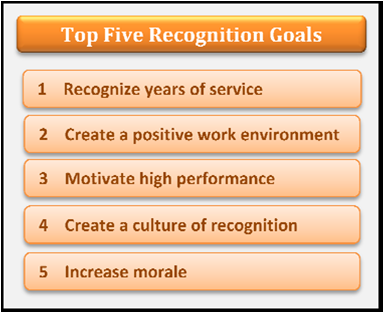WorldatWork just released its 2013 Trends in Employee Recognition report.
The timing is ideal, as earlier this week I blogged about the importance of behavior-based recognition and WorldatWork’s press release about the new report proclaims: “For the first time in the survey’s 11-year history, programs to motivate specific behavior jumped to a top-tier goal, cited by 41 percent of organizations in 2013 vs. 25 percent in 2008.”
Indeed, four of the top five recognition goals for organizations across industries are the focus of strategic, social employee recognition programs.
Morale, motivation, and a positive work culture
The outlier (and still most popular program) is recognizing years of service. I believe this old standby remains at the top of the list because, even when companies find themselves in the toughest financial straits, leadership believes they must honor the loyalty of employees shown for years of service.
I, too, believe this to be important, but traditional years of service recognition alone will not and can not drive achievement of the other four goals of recognition as stated by respondents to the WorldatWork survey. It is truly an outlier.
Let’s look at the others:
- Create a Positive Work Environment – This is foundational to employee engagement. I often comment that leaders cannot engage employees. You can, however, create an environment and culture in which employees choose to engage. Which leads directly into the next goal.

- Create a Culture of Recognition – A culture of recognition is very different from a recognition program. A strategic program that encourages all the right recognition behaviors and actions helps to create this culture by giving everyone the means and ability to easily recognize others for their excellence in a meaningful way (including in their local language for global organizations). Deep insight into the culture in action through detailed, actionable real-time measurement and reporting also helps management keep the culture on track while empowering all employees at every level to own the culture.
- Motivate High Performance – Done correctly – meaning timely, specifically and frequently – recognition reinforces for employees why and how their efforts are meaningful and necessary in helping to achieve a bigger vision or strategic objective. Multiple research sources show this is the most motivating factor for employees to continue to achieve at high level – making progress in meaningful work.
- Reinforce Desired Behaviors – The newest member of the “top five recognition goals” list is gratifying to me as I’ve spent the last 11 years of my career consulting with organizations of all sizes and industries on the importance of exactly this point. It’s a key tenet of strategic recognition as outlined in Winning with a Culture of Recognition. Your organization has already likely defined desired behaviors in the form of your core values or guiding principles. Those should be the factors every recognition moment reinforces across your organization.
I’ll be blogging again on additional findings in report, including consistency in budget for recognition (still 1-2 percent of payroll), international programs, and most desired rewards.
What are your top five goals for your employee recognition program?
You can find more from Derek Irvine on his Recognize This! blog.
